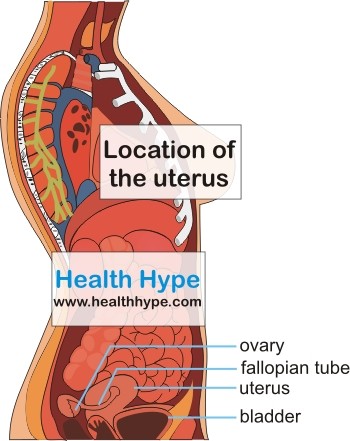Endometriosis – Causes and Symptoms (Pain, Pregnancy, Periods)
What is Endometriosis?
Endometriosis is a condition where tissues of the endometrium (the inner lining of the uterus) develop elsewhere in the body. Normally this tissue should only be located in the uterus. Endometriosis is most commonly seen in the pelvic area or on other organs in the abdominal cavity, but it may rarely develop in distant organs. Pelvic pain, often quite severe and particularly just before the onset of periods, and infertility are the most common symptoms for which medical advice is sought.
However, although endometriosis is a common gynecological condition, the diagnosis is often missed when the symptoms are mild or when there is no other associated cause requiring investigation, such as infertility. Painful sexual intercourse or irregular heavy periods may also be the presenting complaint. The treatment of endometriosis may involve a combination of medication and surgery.
How does endometriosis occur?
Normal Physiology
To understand what happens in endometriosis it is helpful to know a little about the physiology of menstruation. The average menstrual cycle is 28 days long, counted from the first day of menstruation to just before the next period.
Various hormones play their part in regulating the menstrual cycle. Gonadotropin releasing hormone (GnRH) secreted by the hypothalamus acts on the pituitary gland to control production of hormones. The pituitary gland produces hormones such as luteinizing hormone (LH) and follicle-stimulating hormone (FSH) which induce ovulation and stimulate the ovaries to produce estrogen and progesterone.
The endometrium varies in thickness at different times of the menstrual cycle due to the action of estrogen and progesterone. Rising estrogen and progesterone levels help to thicken the endometrium and prepare it for embedding of the embryo if fertilization takes place. If pregnancy does not occur, the hormone levels drop and the uterine lining mixed with blood is shed and comes out as menstrual bleeding.
Pathophysiology of Endometriosis
 In the case of endometriosis, endometrial tissue is found in other parts of the body besides the uterine lining. It may occur on the uterus, ovaries, fallopian tubes, bladder, bowel, rectum or anywhere else within the pelvis or abdominal cavity. Endometrial tissue may even be seen in distant organs such as the brain or lungs or on Cesarean and episiotomy scars.
In the case of endometriosis, endometrial tissue is found in other parts of the body besides the uterine lining. It may occur on the uterus, ovaries, fallopian tubes, bladder, bowel, rectum or anywhere else within the pelvis or abdominal cavity. Endometrial tissue may even be seen in distant organs such as the brain or lungs or on Cesarean and episiotomy scars.
Irrespective of the site, these endometrial tissues behave like the endometrial lining of the uterus during a menstrual cycle. The tissues may bleed and break down each month during a menstrual period. This can give rise to formation of adhesions, especially in the pelvis which may be a contributing factor to the pain, a common symptom of endometriosis.
Endometriosis of the ovary can produce a cyst known as endometrioma. Bleeding within it can cause the formation of a chocolate cyst of the ovary.
What causes endometriosis?
The exact cause of endometriosis is unknown but there are various theories regarding the cause :
- Retrograde menstruation – backflow of menstrual blood and endometrial tissue from the uterus through the fallopian tubes into the pelvis and abdomen.
- Endometrial cells carried via the blood stream or lymph vessels to distant organs.
- Direct implantation of cells at the site of surgical scars.
Risk Factors of Endometriosis
Endometriosis may occur at any age in a menstruating woman but is more often seen in women withe one or more of the following risk factors :
- Women in their 30s or 40s.
- Family history may be present.
- More common in Caucasian (white) women than in African American or Asian women.
- Tall, thin women with low body mass index (BMI).
- Women who have not had any children.
- History of chronic pelvic pain.
- Altered immune state.
- Allergies and asthma.
Symptoms of Endometriosis
Endometriosis can give rise to a wide spectrum of symptoms, ranging from mild to severe, which may not necessarily be related to the extent of disease. Some women may have no symptoms at all and the condition may be diagnosed while investigating for the cause of infertility. Sometimes, endometriosis may be detected during an examination or surgery for an unrelated condition.
The symptoms that are often associated with endometriosis are :
- Pelvic pain and/or low back pain exacerbated before/during periods and during/after sexual intercourse.
- Infertility – inability to fall pregnant.
- Periods may be painful, irregular or heavy.
- Fatigue.
With the involvement of the bowel and bladder in endometriosis there may be symptoms such as
- Pain during bowel movement.
- Bleeding from the rectum during menstruation.
- Swelling of the abdomen.
- Diarrhea or constipation, especially during menstrual periods.
- Painful swelling of the umbilicus (belly button).
- Pain while passing urine.
- Blood in urine.
- Nausea and vomiting – worsening before or during the periods.
Rarely, endometriosis in the lungs can cause chest pain or coughing up of blood while endometriosis in the brain can cause headaches and seizures.
Pain in Endometriosis
Chronic pelvic pain is a common feature of endometriosis. The cause for this is not always clear. Adhesions caused by the break down and bleeding of the endometrial tissues at various sites every month, especially within the abdomen and pelvis, can give rise to pain.
The pain of endometriosis may also be associated with inflammation, with chemical mediators such as prostaglandin playing a role. The severity of pain is not always related to the extent of endometriosis. While a mild condition can give rise to severe pain in some women, in others there may be little or no pain even with extensive spread of the disease.

Pain due to endometriosis usually occurs just before the onset of menstruation and often disappears once the periods start. There may be pain during sexual intercourse (dyspareunia). Painful bowel movement or painful urination may occur when the bowel or bladder is affected.
Apart from NSAIDs, treatment with various hormones is often effective in relieving symptoms of pain in endometriosis. Surgical removal of the endometrial tissues from an abnormal site may be beneficial in more severe cases. A hysterectomy may be contemplated as a last resort when all other treatment for pain fails but chances of recurrence still exists.
Pregnancy and Endometriosis
Women suffering from endometriosis may have difficulty falling pregnant. In fact, many times endometriosis is detected only while trying to find the cause for infertility. On the other hand, the symptoms of endometriosis often subsides once a woman falls pregnant. Endometriosis does not have any negative impact on pregnancy.
Fertility may be affected due to hormones produced in endometriosis that are not conducive for ovulation, fertilization or implantation of the fertilized ovum. Also, there may be anatomical distortion produced by scarring due to endometriosis which may affect the fallopian tubes or other structures in the pelvis.
Dyspareunia caused by endometriosis may restrict sexual intercourse, thus reducing the chances of pregnancy.
Women with severe endometriosis are more likely to suffer from infertility than those with milder form of the disease.
With treatment, pregnancy is possible in many instances. Of the various treatment options, surgical treatment often gives better results than hormonal or other medical treatment. Assisted reproduction techniques such as intrauterine insemination or in-vitro fertilization (IVF) may offer hope to women with endometriosis when combined with surgical treatment.
Periods and Endometriosis
Dysmenorrhea or painful menstruation may be caused by endometriosis but the typical pain of endometriosis usually starts a few days prior to onset of periods and disappears once regular menstrual flow starts. It is more a deep seated pain in the lower abdomen, pelvis and back, and is different from the cramping abdominal pain felt during periods. Endometriosis may cause irregular, heavy periods. Spotting and bleeding between periods may also be seen.
References
- Endometriosis. Medscape
- Endometriosis Slideshow. WebMD




